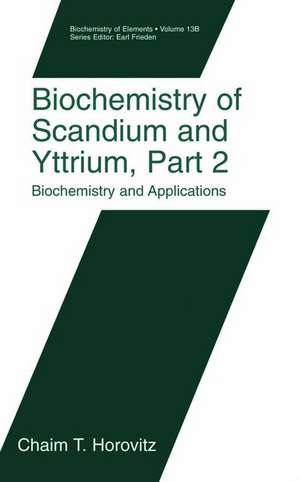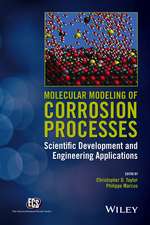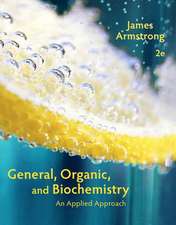Biochemistry of Scandium and Yttrium, Part 2: Biochemistry and Applications: Biochemistry of the Elements, cartea 13B
Autor Chaim T. Horovitzen Limba Engleză Hardback – 31 iul 2000
Improved analytical techniques have revealed that scandium and yttrium are present throughout living matter, even though only a relatively limited number of species have been analyzed so far. This fact of course has far-ranging implications for biological and environmental concerns.
The major impacts of scandium and yttrium in science, technology, and medicine will be of interest to a wide variety of researchers, including geochemists, inorganic and organic chemists, clinical biochemists, and those specializing in environmental protection.
| Toate formatele și edițiile | Preț | Express |
|---|---|---|
| Paperback (1) | 640.88 lei 43-57 zile | |
| Springer Us – 3 oct 2012 | 640.88 lei 43-57 zile | |
| Hardback (1) | 648.42 lei 43-57 zile | |
| Springer Us – 31 iul 2000 | 648.42 lei 43-57 zile |
Din seria Biochemistry of the Elements
- 15%
 Preț: 647.08 lei
Preț: 647.08 lei - 5%
 Preț: 1620.56 lei
Preț: 1620.56 lei - 5%
 Preț: 1102.82 lei
Preț: 1102.82 lei - 18%
 Preț: 1222.94 lei
Preț: 1222.94 lei - 18%
 Preț: 946.72 lei
Preț: 946.72 lei - 15%
 Preț: 640.88 lei
Preț: 640.88 lei - 15%
 Preț: 642.83 lei
Preț: 642.83 lei - 15%
 Preț: 600.90 lei
Preț: 600.90 lei - 15%
 Preț: 646.75 lei
Preț: 646.75 lei - 15%
 Preț: 640.71 lei
Preț: 640.71 lei - 5%
 Preț: 373.68 lei
Preț: 373.68 lei - 18%
 Preț: 1230.84 lei
Preț: 1230.84 lei - 15%
 Preț: 648.42 lei
Preț: 648.42 lei - 15%
 Preț: 649.71 lei
Preț: 649.71 lei - 5%
 Preț: 369.29 lei
Preț: 369.29 lei - 5%
 Preț: 720.47 lei
Preț: 720.47 lei
Preț: 648.42 lei
Preț vechi: 762.85 lei
-15% Nou
Puncte Express: 973
Preț estimativ în valută:
124.08€ • 129.87$ • 103.27£
124.08€ • 129.87$ • 103.27£
Carte tipărită la comandă
Livrare economică 31 martie-14 aprilie
Preluare comenzi: 021 569.72.76
Specificații
ISBN-13: 9780306456572
ISBN-10: 0306456575
Pagini: 303
Ilustrații: XIV, 303 p.
Dimensiuni: 152 x 229 x 22 mm
Greutate: 0.64 kg
Ediția:2000
Editura: Springer Us
Colecția Springer
Seria Biochemistry of the Elements
Locul publicării:New York, NY, United States
ISBN-10: 0306456575
Pagini: 303
Ilustrații: XIV, 303 p.
Dimensiuni: 152 x 229 x 22 mm
Greutate: 0.64 kg
Ediția:2000
Editura: Springer Us
Colecția Springer
Seria Biochemistry of the Elements
Locul publicării:New York, NY, United States
Public țintă
ResearchCuprins
7. Interactions of Scandium and Yttrium within Cells, Cellular Organelles, and Tissues.- 7.1 Introduction.- 7.2 Membrane Interactions.- 7.3 Interactions with Cells and Cellular Organelles.- 7.4 Interactions with Antibodies.- 7.5 Interactions with Tissues and Organs.- 7.6 Summary.- References.- 8. Biochemistry and Physiology of Scandium and Yttrium.- 8.1 Introduction.- 8.2 Cytological and Morphological Patterns.- 8.3 Biochemistry in Lower Organisms (Monera, Protoctista, Fungi).- 8.4 Biochemistry in Plants.- 8.5 Biochemistry in Lower Animals (Mollusca, Arthropoda).- 8.6 Biochemistry in Fish and Birds.- 8.7 Biochemistry in Mammals.- 8.8 Biochemistry in Humans.- 8.9 Nutrition and Diet.- 8.10 Involvement in Enzymes and in Main and Secondary Metabolism.- 8.11 Membranes and Transport.- 8.12 Involvement in Physiological Processes.- 8.13 Patterns in Disease and Pathological Conditions.- 8.14 Effects on Genetic and Immunologic Processes.- 8.15 Comparison to Lanthanides, Aluminum, and Other Trace Elements.- 8.16 Essentiality, Hormesis, and Other Theoretical and Practical Approaches.- 8.17 Summary.- References.- 9 Toxicology, Carcinogenicity, and Pharmacology of Scandium and Yttrium.- 9.1 Introduction.- 9.2 Toxic Effects on Microorganisms.- 9.3 Toxic Effects on Plants.- 9.4 Toxic Effects on Animals.- 9.5 Acute Toxicity.- 9.6 Chronic Toxicity.- 9.7 Toxic Ocular and Skin Effects.- 9.8 Toxic Effects on Heart, Liver, Lung, and Other Organs.- 9.9 Biochemistry and Molecular Biology of Toxicity.- 9.10 Pathologic Effects.- 9.11 Genetic Effects.- 9.12 Immunologic Effects.- 9.13 Pharmacological Effects.- 9.14 Toxic Effects on Humans.- 9.15 Carcinogenicity, Mutagenicity, and Teratogenicity.- 9.16 Radiotoxicity.- 9.17 Hazard, Occupational, and Environmental Impacts.- 9.18 Summary.- References.- 10 Biochemical and Other Techniques that Employ Yttrium and Scandium. Outlook.- 10.1 Introduction.- 10.2 Stable and Radioactive Isotopes as Markers in Nutrition Research.- 10.3 Mimicking Action of Calcium Cellular Fluxes and Metabolism.- 10.4 Blood Flow and Microsphere Therapy.- 10.5 Radiolabeling of Antibodies and Other Compounds.- 10.6 Other Biochemical and Medical Applications.- 10.7 Biological, Agricultural, and Environmental Applications.- 10.8 Applications in Industry and Technology.- 10.9 Outlook.- References.- Suggested Further Reading.





